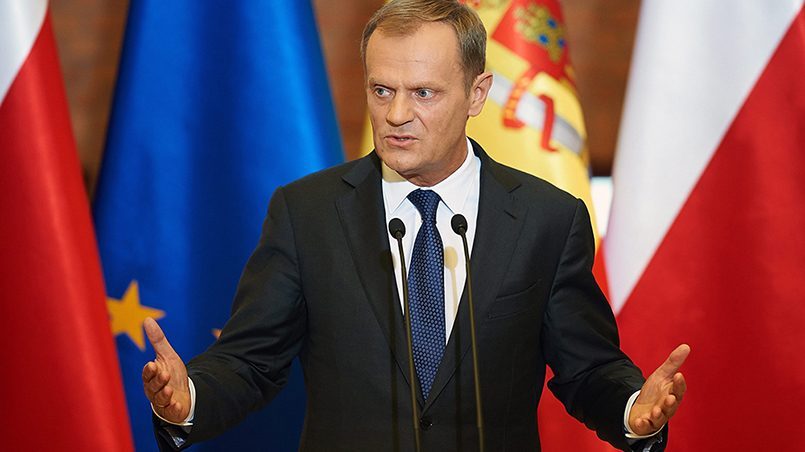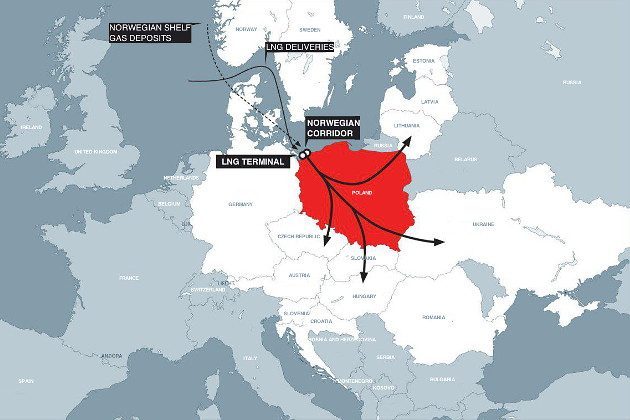Poland's ruling party Law and Justice (Prawo i Sprawiedliwoś) has announced plans to revive the Baltic Pipe Project - construction of an underwater pipeline in order to pump Norwegian North Sea offshore gas. Warsaw wants to connect the Norwegian and Danish gas transportation systems with the subsequent construction of a branch from Denmark to Poland across the bottom of the Baltic Sea. How realistic is that? And why even after the commissioning of its own LNG terminal, Poland has not acquired its desired energy “independence” from Russia?
The Baltic Pipe Project was first discussed in 2001 when the Danish oil and gas company DONG and the Polish PGNiG signed the contract to construct a gas pipeline with a capacity of 5 Billion cubic meters (bcm) of natural gas per year. The project remained on paper due to economic reasons. In 2016, Poland gained energy «independence» from Russia in the form of its own LNG terminal. But a year after its launch, the Polish authorities are talking about construction of a gas corridor from Norway.
This time, the plans are much bigger – to finish the project by 2022 when the long-term contract with Gazprom expires (8.5 bcm of gas per year), an underwater pipeline with a capacity of 10 bcm. All in order to completely abandon Russian LNG, whose share in the country's import reaches 80%.
So what is the actual reason for this decision to revive the Baltic Pipe Project? First of all, the unprofitability of the LNG terminal put into operation in 2016. Its construction was initiated by Poland Prime Minister Donald Tusk and has cost the state nearly 1 bln USD.

The peculiarity of this infrastructure project was that it, while still unfinished is already a source of losses for the Polish budget. During the terminal’s design stages (the construction itself, which began in 2011, was to end in 2013), Polish authorities have already signed a 20-year contract with Qatar Gas for the supply of LNG on «take or pay» terms. Poland has committed to receiving up to 1.5 bcm of gas annually starting from 2014.
Apparently, none of the Polish politicians even cared about the possible financial risks in case of setbacks during construction. They wanted to hype up their “contract of the century” so much. And it happened just like that. The first commercial cargo was received only in the summer of 2016. However, Qatar demanded that Poland comply with the terms of the contract. As a result of the compromise, the Qataris agreed to sell Polish gas to other buyers before the terminal was put into operation, and Warsaw pledged to compensate for the price difference, as well as to buy out volumes that Qatar Gas will not be able to sell.
That is, without yet having the technical ability to accept the gas, Warsaw has already begun to incur losses, paying the costs of this Middle Eastern state.
In 2017, the sides signed an additional agreement to the contract, according to which starting from 2018 Poland will annually purchase up to 2.7 bcm of gas (the contract lasting until 2034). In the same year, a five-year contract was also signed with Centrica LNG for the supply (starting from 2018) of LNG from the United States (nine deliveries from the LNG terminal Sabine Pass in Louisiana).
So why, having guaranteed long-term contracts, do the Polish authorities want to promote an alternative to the LNG terminal?
This political decision is primarily due to the unprofitability of the terminal and the high cost of its maintenance. Comparative analysis of prices for Russian, American, Qatari and Norwegian gas supplied to Europe speaks for itself. In 2017, the average price of Gazprom`s gas to European consumers was varied in the range of 180-190 USD per thousand cubic meters. America’s export price to Europe is roughly 280 USD. Norway - 190 USD. Qatar - 300 USD.
And current maintenance of the terminal is not cheap. According to the managing company of the terminal, Polskie LNG, the annual costs of its operation are estimated at 50 million USD.
How much would it cost Poland the construction of the Norwegian gas corridor and will it be competitive to the Russian natural gas?
According to Polish calculations, investments will amount to 1.8 bln euros. «Norway PGNiG Upstream» (subsidiary of PGNiG), which is involved in 21 of the concession and extracting oil and gas from deposits of Skarv, Vilje, Morvin, Vale, Gina Krog, will be responsible for filling the pipe. Over the past 10 years, the Poles have invested about 1 bln euros in the development of the Norwegian continental shelf. To date, since the start of production in 2012, about 2 bcm of gas has been received (0.4 bcm per year). Poland plans to increase production by 2022 on Polish concessions to 2.5 bcm per year.
This does not resolve the issue of replacing Russian gas. We still need to find about 6 bcm. Norway has limited capacity of export gas. Today it supplies its customers under long-term contracts 90% of its gas produced (in 2017 – 120 bcm).
Current production levels are the limits of the Norwegian oil and gas sector. In the future, the pace and volume will only decrease. In this regard, there is a risk that the pipe will be utilized only by a third.
The project’s economy itself raises somequestions. The approximate cost of the 230 km gas pipeline will be 1.8 bln euros (cost of 1 km – 7.8 mln euros). For comparison, Nord stream which has a length of 1224 km (the volume of investments - 9 bln euros), cost 7.3 mln euros per km. The payback of such projects is approximately 14-15 years. That is, in order to get the return on investments the price of gas for the end user should be adjusted accordingly. Let's take the volume of gas production on concessions in Norway planned by Poland by 2020 as a baseline scenario (2.4 bcm per year). An annual return at payback in 15 years with capital investment of 1.8 bln euros should be 120 mln euros. Respectively, the price for one thousand cubic meters will include the investment component amounting to 50 euros.
At current gas prices in Europe, the cost of Polish gas will be approximately 240 euros per thousand cubic meters.
It is also necessary to take into account the transportation costs through the Norwegian GTS to Denmark. In Norway, all oil and gas companies pay the local monopolist Gassled for the use of gas transportation infrastructure (an average of 40 USD per thousand cubic meters of gas). One will also have to pay for the Danish GTS services. And finally no one canceled the operating costs for the maintenance of the Baltic Pipe pipeline itself.

In the end the final cost for one thousand cubic meters may be more than 300 euros.
There is a reasonable question - what is the economic feasibility of the Baltic Pipe project? And why would Poland give up on Russian gas after 2022? After all, for Warsaw this project carries nothing but risks: from the failure of the commission timeframe, as with the LNG terminal, as well as pipe downtime. And most importantly, to date no one has expressed a desire to finance this project. It would be naive to count on European assistance in the face of Warsaw's confrontation with Brussels, as well as the plans announced by the European Commission to reduce in connection with Brexit budget expenditures for the 2020-2027 period.
Russia in turn treats the Polish plans with understanding. As Russian President Vladimir Putin said, «Moscow will offer these volumes to other countries», while expressing confidence that «the buyer will be find».
Throughout this story, it is a real pity that Polish citizens may have to bear another financial burden due to another unprofitable geopolitical project.







